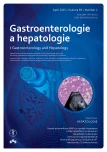-
Medical journals
- Career
Esophageal motility disorders – The Chicago classification, v3.0
Authors: Martin Ďuriček; Peter Bánovčin; R. Hyrdel
Authors‘ workplace: Interná klinika gastroenterologická JLF UK a UN Martin
Published in: Gastroent Hepatol 2015; 69(2): 130-138
Category: Clinical and Experimental Gastroenterology: Review Article
doi: https://doi.org/10.14735/amgh2015130Overview
The last classification of oesophageal motility disorders was developed in 2012 based on high resolution manometry (HRM). Since then, the use of HRM in clinical practice and clinical studies brought significant knowledge and a new perspective on measured data interpretation. This information was necessary to be taken into account when developing the reclassification. The updated Chicago classification v3.0 is more concise and synoptic and significantly approximates to the clinical practice. It results from a meeting of members of the International Working Group on HRM (International HRM Working Group) in 2014 in Chicago. The article brings new classification with an emphasis on the most important changes as compared to the previous version.
Key words:
esophageal manometry – Chicago classification – peristalsis of the esophagus – the lower oesophageal sphincter
The authors declare they have no potential conflicts of interest concerning drugs, products, or services used in the study.
The Editorial Board declares that the manuscript met the ICMJE „uniform requirements“ for biomedical papers.Submitted:
17. 3. 2015Accepted:
6. 4. 2015
Sources
1. Pandolfino JE, Fox MR, Bredenoord AJ et al. High‑resolution manometry in clinical practice: utilizing pressure topography to classify oesophageal motility abnormalities. Neurogastroenterol Motil 2009; 21(8): 796 – 806. doi: 10.1111/ j.1365 ‑ 2982.2009.01311.x.
2. Pandolfino JE, Kahrilas PJ. AGA technical review on the clinical use of esophageal manometry. Gastroenterology 2005; 128(1): 209 – 224.
3. Bredenoord AJ, Fox M, Kahrilas PJ et al. Chicago classification criteria of esophageal motility disorders defined in high resolution esophageal pressure topography. Neurogastroenterol Motil 2012; 24 (Suppl 1): 57 – 65. doi: 10.1111/ j.1365 ‑ 2982.2011.01834.x.
4. Kahrilas PJ, Bredenoord AJ, Fox M et al. The Chicago classification of esophageal motility disorders, v3.0. Neurogastroenterol Motil 2015; 27(2): 160 – 174. doi: 10.1111/ nmo.12477.
5. Fremundová L, Balihar K, Koželuhová Jet al. Manometrie jícnu. Gastroent Hepatol 2013; 67(4): 250 – 260.
6. Lin Z, Pandolfino JE, Xiao Y et al. Localizing the contractile deceleration point (CDP) in patients with abnormal esophageal pressure topography. Neurogastroenterol Motil 2012; 24(10): 972 – 975. doi: 10.1111/ j.1365 ‑ 2982.2012.01959.x.
7. Roman S, Gyawali CP, Xiao Y et al. The Chicago classification of motility disorders: an update. Gastrointest Endosc Clin N Am 2014; 24(4): 545 – 561. doi: 10.1016/ j.giec.2014.07.001.
8. Roman S, Pandolfino JE, Chen J et al. Phenotypes and clinical context of hypercontractility in high‑resolution esophageal pressure topography (EPT). Am J Gastroenterol 2012; 107(1): 37 – 45.
9. Roman S, Kahrilas PJ. Distal esophageal spasm. Dysphagia 2012; 27(1): 115 – 123. doi: 10.1007/ s00455 ‑ 011 ‑ 9388 ‑ 3.
10. Kumar N, Porter RF, Chanin JM et al. Analysis of intersegmental trough and proximal latency of smooth muscle contraction using high‑resolution esophageal manometry. J Clin Gastroenterol 2012; 46(5): 375 – 381. doi: 10.1097/ MCG.0b013e31823d3403.
11. Roman S, Lin Z, Kwiatek MA et al. Weak peristalsis in esophageal pressure topography: classification and association with Dysphagia. Am J Gastroenterol 2011; 106(2): 349 – 356. doi: 10.1038/ ajg.2010.384.
12. Pandolfino JE, Roman S, Carlson D et al. Distal esophageal spasm in high‑resolution esophageal pressure topography: defining clinical phenotypes. Gastroenterology 2011; 141(2): 469 – 475. doi: 10.1053/ j.gastro.2011.04.058.
13. Pandolfino JE, Kim H, Ghosh SK et al. High resolution manometry of the EGJ: an analysis of crural diaphragm function in GERD. Am J Gastroenterol 2007; 102(5): 1056 – 1063.
14. Kahrilas PJ, Peters JH. Evaluation of the esophagogastric junction using high resolution manometry and esophageal pressure topography. Neurogastroenterol Motil 2012; 24 (Suppl 1): 11 – 19. doi: 10.1111/ j.1365 ‑ 2982.2011.01829.x.
15. Bredenoord AJ, Weusten BL, Timmer R et al. Intermittent spatial separation of diaphragm and lower esophageal sphincter favors acidic and weakly acidic reflux. Gastroenterology 2006; 130(2): 334 – 340.
16. Shaker A, Stoikes N, Drapekin J et al.Multiple rapid swallow responses during esophageal high‑resolution manometry reflect esophageal body peristaltic reserve. Am J Gastroenterol 2013; 108(11): 1706 – 1712. doi: 10.1038/ ajg.2013.289.
Labels
Paediatric gastroenterology Gastroenterology and hepatology Surgery
Article was published inGastroenterology and Hepatology

2015 Issue 2-
All articles in this issue
- Noninvasive diagnostics in NAFLD
- Autochthonous case of hepatitis E virus in Slovakia
- Twenty years of experience with ERCP in the University Hospital Motol
- Esophageal motility disorders – The Chicago classification, v3.0
- Atypical picture of colon infiltration with lymphoma in a patient with chronic lymphocytic leukaemia
- Vedolizumab in the therapy of Crohn’s disease
- Novel oral anticoagulants – the advantages and drawbacks of the therapy
- Report of XXth Gastroforum
- ECCO – Inflammatory Bowel Diseases 2015
- IBD working days 2015, Hořovice
- New web platform of Gastroenterology and Hepatology journal and co-operation with the National Library of Medicine
- Informations from the editors
- Maltofer®
- Not only about hepatitis
- Therapy of chronic hepatitis C with simeprevir
- Functional variants of metalloproteinase MMP‑ 1 and MMP‑ 7 genes have no relationship to the severity of portal hypertension in patients with cirrhosis
- Gastroenterology and Hepatology
- Journal archive
- Current issue
- Online only
- About the journal
Most read in this issue- Maltofer®
- Atypical picture of colon infiltration with lymphoma in a patient with chronic lymphocytic leukaemia
- Novel oral anticoagulants – the advantages and drawbacks of the therapy
- Esophageal motility disorders – The Chicago classification, v3.0
Login#ADS_BOTTOM_SCRIPTS#Forgotten passwordEnter the email address that you registered with. We will send you instructions on how to set a new password.
- Career

